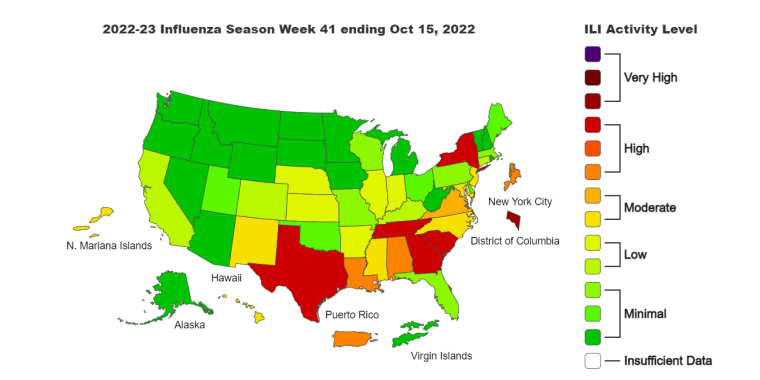An unseasonal early surge of respiratory viruses among babies and toddlers has caught doctors off guard and worried about the coming months.
Pediatricians and children's hospitals were prepared for a bad flu season. They were not ready for a multitude of viruses to come all at once and earlier than expected.
"There is no one virus that's causing pediatric respiratory viruses this fall," said Dr. Deanna Behrens, a pediatric critical care physician at Advocate Children's Hospital in suburban Chicago. "Unfortunately, it's all of them."
Babies and preschool-aged children are coming down with the flu, respiratory syncytial virus (RSV), parainfluenza viruses, adenoviruses, rhinoviruses and enteroviruses in ways never before imagined, Behrens and other infectious diseases experts said.
"We see kids where, when we do the nasal swab, not only do they test positive for influenza, but they may have RSV or enterovirus or adenovirus at the same time," said Dr. Mark Kline, the physician-in-chief at Children's Hospital New Orleans. "We've seen kids where we've gotten two or three viruses at once."
A third of hospitalizations for the flu are in children, the Centers for Disease Control and Prevention told NBC News in a statement. A third of those hospitalizations are in kids under age 5.
Babies and toddlers are most at risk for severe respiratory illness. Their tiny airways and infantile immune systems have trouble clearing the buildup of mucus that comes with colds and other respiratory illnesses.
The CDC data come from FluSurv-NET, which covers counties in 14 states, representing about 9% of the U.S. population.
The flu is spreading at an especially high rate in Georgia, New York, South Carolina, Tennessee, Texas and Washington, D.C., according to the latest flu report from the CDC. Of the children hospitalized for flu, 80%, according to FluSurv-NET, are in Georgia.

While RSV is inundating many children's hospitals, the number of pediatric flu cases is also increasing. "We've seen numbers doubling on a weekly basis," said Dr. Sarah Combs, an emergency medicine physician at Children's National in Washington, D.C.
Why are RSV, other viruses on the rise?
Viruses thrive in populations that have never experienced them. It's why small children are most vulnerable now to respiratory viruses. When the pandemic hit in 2020, those children were mostly home for their first few years of life, cocooned from viruses that, in general, strengthen their infantile immune systems. When they weren't exposed, they were left vulnerable.
"What we lacked is a couple of years of little kids developing the immunity that's needed to keep these colds at bay," said Dr. Buddy Creech, a pediatric infectious disease expert at the Vanderbilt University Medical Center in Nashville, Tennessee. "We may be in for a rough six or seven weeks with influenza and RSV."
Indeed, "reduced population immunity to circulating respiratory illnesses, particularly among young children who may never have had exposure or been vaccinated, could bring about a robust return of flu and other respiratory viruses, like RSV," Lynnette Brammer, team lead of the Domestic Influenza Surveillance Team at the CDC, wrote in an email.
The viruses are also popping up earlier than what would normally be expected. Even though the flu typically peaks between December and February, cases are rising steadily, especially in the Southeast.
"I don't know that we're all quite emotionally ready for RSV and flu season," Creech said. "We knew this was going to be a half-marathon style of a race. Now it looks like it may be even longer. Maybe it's a whole marathon."
The fast, severe rise in pediatric cases is contributing to pressure on hospitals.
In 17 states, pediatric hospital bed occupancy is at 80% or greater, according to data from the Department of Health and Human Services. Nationwide, nearly 75% of the country's estimated 40,000 pediatric beds are full — months before their anticipated winter peak.
Most kids with the flu, Kline said, have typical symptoms: fever, sore throat, cough, body aches and fatigue. But the fact that kids are testing positive for multiple respiratory viruses at once can blur the signs of any one virus. RSV can cause symptoms similar to the flu.
Indeed, RSV "has hit earlier and harder," said Dr. Sarah Combs, an emergency medicine physician at Children's National in Washington, D.C. Combs said her staff is in the midst of a surge in RSV cases.
"We normally expect to see that in the November-December time frame," she said. In addition to RSV, Combs expects the number of pediatric flu illnesses to double in the coming weeks. In 2021, Children's National treated eight flu cases in kids between July and October. In 2022 so far, Combs and her colleagues have treated 80 such children. It's a tenfold increase over last year.
The early surge in pediatric viral illness has caught many clinicians "off guard," said Callie Dobbins, a nurse and facility executive at Levine Children's Hospital in Charlotte, North Carolina.
"We just stabilized from the pandemic, and now we're engulfed with children who need us," she said.
Other viruses, too, are affecting children. Creech said his team continues to see croup, which is caused by parainfluenza virus. And just last month, the CDC issued an advisory about a particular type of enterovirus, called EV-D68.
"Our enterovirus numbers are not ideal right now. They're still very high," Creech said.
Although it primarily causes acute respiratory illness, EV-D68 has been associated with acute flaccid myelitis (AFM), a rare polio-like condition that can cause limb weakness and other problems within the nervous system.
It's flu, however, that's most concerning for pediatricians, for now, at least.
"What we're planning for is a more severe flu season, specifically for children," Dobbins said, "We expect this challenge that we're experiencing now to continue through flu season."
Follow NBC HEALTH on Twitter & Facebook.
